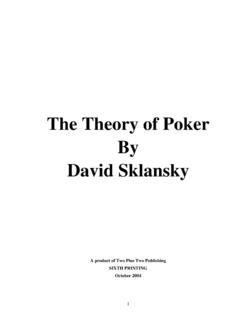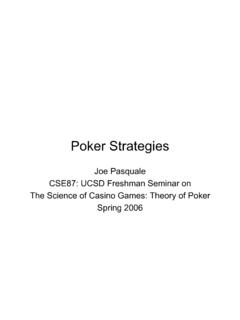Transcription of An Introduction to Counterfactual Regret Minimization
1 An Introduction to Counterfactual Regret Minimization Todd W. Neller Marc Lanctot . July 9, 2013. 1 Motivation In 2000, Hart and Mas-Colell introduced the important game-theoretic algorithm of Regret matching. Players reach equilibrium play by tracking regrets for past plays, making future plays proportional to positive regrets. The technique is not only simple and intuitive; it has sparked a revolution in computer game play of some of the most difficult bluffing games, including clear domination of annual computer poker competitions. Since the algorithm is relatively recent, there are few curricular materials available to introduce Regret -based algorithms to the next generation of researchers and practitioners in this area. These materials represent a modest first step towards making recent innovations more accessible to advanced Computer Science undergraduates, graduate students, interested researchers, and ambitious practition- ers.
2 In Section 2, we introduce the concept of player Regret , describe the Regret -matching algorithm, present a rock-paper-scissors worked example in the literate programming style, and suggest related exercises. Counterfactual Regret Minimization (CFR) is introduced in Section 3 with a worked example solving Kuhn Poker. Supporting code is provided for a substantive CFR exercise computing optimal play for 1-die-versus-1-die Dudo. In Section 4, we briefly mention means of cleaning approximately optimal computed policies, which can in many cases improve results. Section 5 covers an advanced application of CFR to games with repeated states ( through imperfect recall abstraction) that can reduce computational complexity of a CFR training iteration from exponential to linear.
3 Here, we use our independently devised game of Liar Die to demonstrate application of the algorithm. We then suggest that the reader apply the technique to 1-die-versus-1-die Dudo with a memory of 3 claims. In Section 6, we briefly discuss an open research problem: Among possible equilibrium strategies, how do we compute one that optimally exploits opponent errors? The reader is invited to modify our Liar Die example code to so as to gain insight to this interesting problem. Finally, in Section 7, we suggest further challenge problems and paths for continued learning. 2 Regret in Games In this section, we describe a means by which computers may, through self-simulated play, use regrets of past game choices to inform future choices.
4 We begin by introducing the familiar game of Rock- Paper-Scissors (RPS), Roshambo. After defining foundational terms of game theory , we discuss Regret matching and present an algorithm computing strategy that minimizes expected Regret . Using this algorithm, we present a worked example for learning RPS strategy and associated exercises. Gettysburg College, Department of Computer Science, Campus Box 402, Gettysburg, PA. 17325-1486. Department of Knowledge Engineering, Maastricht University 1. July 9, 2013 2. Rock-Paper-Scissors Rock-Scissors-Paper (RPS) is a two-player game where players each simultaneously make one of three gestures: rock (a closed fist), paper (an open face-down palm), or scissors (exactly two fingers extended).
5 With each gesture, there is an opportunity to win, lose, or draw against the other player. Players showing the same gesture draw. A rock wins against scissors, because rock breaks scissors . Scissors wins against paper, because scissors cuts paper . Paper wins against rock, because paper covers rock . Players will commonly synchronize play by calling out a four-beat chant, Rock! Paper! Scissors! Shoot! , bobbing an outstretched fist on the first three beats, and committing simultaneously to one of the three gestures on the fourth beat. Game Theoretic Definitions What does it mean to play such a game optimally or perfectly? Does this question itself hold any meaning, given that maximizing wins minus losses depends on how the opponent plays?
6 In this section, we introduce some fundamental terminology and definitions from game theory , and consider solution concepts for optimal play. Here, we follow the notation and terminology of [12]. First, let us define a normal-form game as a tuple (N, A, u), where: N = {1, .., n} is a finite set of n players. Si is a finite set of actions or choices for player i. A = S1 .. Sn is the set of all possible combination of simultaneous actions of all players. (Each possible combination of simultaneous actions is called an action profile.). u is a function mapping each action profile to a vector of utilities for each player. We refer to player i's payoff as ui . A normal-form game is commonly also called a one-shot game since each player only makes a single choice.
7 One can represent such games as an n-dimensional table, where each dimension has rows/columns corresponding to a single player's actions, each table entry corresponds to a single action profile (the intersection of a single action from each player), and the table entry contains a vector of utilities ( payoffs or rewards) for each player. The payoff table for RPS is as follows: R P S. R 0, 0 1, 1 1, 1. P 1, 1 0, 0 1, 1. S 1, 1 1, 1 0, 0. where each entry has the form (u1 , u2 ). By convention, the row player is player 1 and the column player is player 2. For example, in RPS, A = {(R, R), (R, P ), , (S, P ), (S, S)}. A normal-form game is zero-sum if the values of each utility vector sum to 0. Constant-sum games, where the values of each utility vector sum to a constant, may be reformulated as zero-sum games by adding a dummy player with a single dummy action that always receives the negated constant as a payoff.
8 A player plays with a pure strategy if the player chooses a single action with probability 1. A. player plays with a mixed strategy if the player has at least two actions that are played with positive probability. We use to refer to a mixed strategy, and define i (s) to be the probability of player i chooses action s Si . By convention, i generally refers to player i's opponents, so in a two-player game S i = S3 i . To compute the expected utility of the game for an agent, sum over each action profile July 9, 2013 3. the product of each player's probability of playing their action in the action profile, times the player's utility for the action profile: X X. ui ( i , i ) = i (s) i (s0 )ui (s, s0 ), s Si s0 S i in the two-player case.
9 A best response strategy for player i is one that, given all other player strategies, maximizes expected utility for player i. When every player is playing with a best response strategy to each of the other player's strategies, the combination of strategies is called a Nash equilibrium. No player can expect to improve play by changing strategy alone. Consider the Battle of the Sexes game: Gary M G. M 2, 1 0, 0. Monica G 0, 0 1, 2. Monica is the row player, and Gary is the column player. Suppose Monica and Gary are going out on a date and need to choose an activity ( movie, restaurant, etc.). Gary would like to go to a football game (G) and Monica wants to see a movie (M ). They both prefer going together to the same activity, yet each feels less rewarded for choosing the other's preference.
10 Suppose Monica always chooses M . Gary is better off choosing M and has no incentive to unilat- erally deviate from that pure strategy. Likewise, if Gary always chooses G, Monica has no incentive to unilaterally deviate from her pure strategy. The utility is always (2, 1) or (1, 2). So, (M, M ) and (G, G). are two pure Nash equilibria profiles. However, there is a mixed strategy Nash equilibrium as well. An equilibrium can be reached when each player, seeing other strategies, is indifferent to the choice of action, all are equally good. What would have to be the case for Monica to be indifferent to the Gary's choice? Let Gary (M ) = x be the probability of Gary choosing the movie. Then the utility that Monica expects is 2x + 0(1 x).


